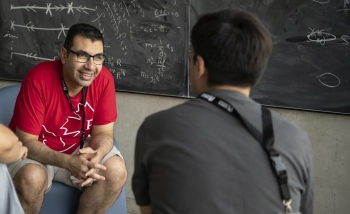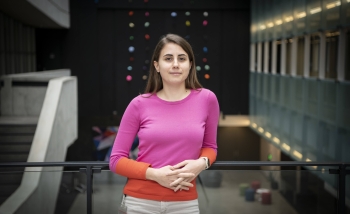What can soap bubbles teach us about quantum field theory? A lot – as Perimeter researchers outline in a pair of recent papers.
Quantum field theory is one of the most successful and flexible tools physicists have ever developed. It’s at the root of fields from particle physics to string theory and condensed matter. But, successful as it is, quantum field theory remains very mysterious. It is still an open challenge to tame it in the so-called strong coupling regime.
“Coupling strength” refers to the strength of the force between two particles. Of the four known forces, three – the electromagnetic force, the gravitational force, and the weak force that is responsible for nuclear fission – are said to be weakly coupled. But the fourth force, the strong force, which binds quarks together to make up atomic nuclei, is strongly coupled. It binds quarks together so tightly that single quarks are never seen in isolation. In fact, we think that it’s impossible for a single quark to exist in isolation.
We think – but we don’t really know. Likewise, we know that the strong force is carried by gluons (so called because they “glue” quarks together), in the same way that the electromagnetic force is carried by photons. But though we can accurately calculate what’s likely to happen when two photons meet, the meeting of two gluons is a tremendously sticky problem.
Predicting what’s likely to happen when particles interact is done by calculating something called “scattering amplitudes.” To calculate scattering amplitudes, you have to consider everything that might happen when two particles meet, and how likely each of these things is. Because gluons are so strongly coupled – so sticky – the range of things that can happen is huge.
Faculty member Pedro Vieira, postdoctoral researcher Benjamin Basso (now at ENS) and postdoctoral researcher Amit Sever (now at the Institute for Advanced Study) collaborated on the soap bubble work. Vieira explains the problem with predicting gluon scattering amplitudes: “Sometimes two gluons go by and don’t interact. Sometimes they go by each other and exchange a single gluon. Sometimes they exchange 20 gluons. Sometimes they exchange 20 gluons which then also produce and exchange gluons of their own. There are so many things that can happen that scattering amplitudes are tough things to compute.”
It’s such a tough problem that researchers study it in a simplified context, a very special arena known technically as N=4 Super Yang-Mills theory. While solving a quantum field theory such as N=4 does not tell you how particles will act in nature, it can point the way to new solutions. It’s like studying a map instead of studying the wilderness you’re lost in.
One of the special features of N=4 is that the coupling constant – the number that shows how “sticky” a particle is – can be turned up and down like a dial. That makes it possible to study the scattering of gluons inside N=4 in a way that just isn’t possible in the real world.
N=4 has a surprise feature, too – not only can it deal with minimally sticky gluons, but also with maximally sticky gluons. Or to put the same thing another way, researchers can calculate scattering amplitudes for strongly coupled gluons. But they don’t do this in the traditional way – they don’t consider everything that might happen and calculate probabilities for each possibility. Instead, they use a geometric shortcut made possible by string theory. At very strong couplings, each scattering amplitude is associated with a polygon.
Vieira walks through the polygon technique, which was discovered by Alday and Maldacena in 2007. “The first step is to count the number of particles,” Vieira says. “For example, if you smash two gluons together and get four – for a total of six gluons – your polygon will have six sides. Each scenario is like that: it is associated with a polygon with a number of sides equal to the number of particles.”
Researchers then take that polygon and mentally build it out of wire and dip it in soap, as if to blow bubbles. The surface area of soap film is the scattering amplitude.
The discovery of the polygon picture made both the weak coupling and the strong coupling tractable, albeit via two different methods. The remaining challenge is the most difficult one: to come up with a single framework that could address strong, weak, and everything in between. This is technically known as solving scattering amplitudes for finite couplings, and it has long been a huge and outstanding problem in the field.
Perimeter researchers found such a method. They did it by extending the polygon technique.
Vieira explains the challenge of the extension: “Let’s say we start with strong coupling and start turning the coupling down. What happens is that the soap film surface, which was stretched tight at high coupling, starts to vibrate quantum mechanically. You no longer have one minimal surface, but rather you have to consider a variety of possibilities.”
This is a bit like throwing a ball – if it’s heavy, it follows an easily calculable trajectory. But if it’s light, the ball starts to be buffeted about by unpredictable gusts of wind. All those wind-blown possibilities need to be considered. Similarly, as the coupling strength turns down inside N=4, researchers had to consider not just the stretched-taut surface of one soap film, but a variety of surfaces with all kinds of different wobbles in them.
“Our main trick was to simplify the computation,” says Vieira. “Instead of computing the area of a very complicated soap film, we considered patches of the soap film. We broke the polygon up and separated it into many tiles, which we called squares. Then, we studied the transition between each two adjacent squares and found a way to add two squares together.”
Using this square-adding method over and over again, the researchers were able to sum over all possible surfaces. The result was a method that – at last – could calculate scattering amplitudes at any coupling strength.
It’s a major result, and part of a growing trend toward using geometric figures to calculate scattering amplitudes. (Also in this family is the work of Perimeter Faculty member Freddy Cachazo et al., highlighted online here.) The Perimeter researchers believe it will open the door for the full-finite coupling solution.
But this work may mean more than an easier, more flexible method for calculating scattering amplitudes. In physics, it is often the case that when the results of calculations are much simpler than expected, then there is some principle or symmetry that has been missed. It is not yet clear whether that’s true in this case, but it is on everyone’s mind.
Benjamin Basso speaks to the point: “We didn’t see something like the minimal soap film surface in our results – we saw the precise minimal surface arising at strong coupling. And it just fell so naturally out of the math. It was like watching strings emerge from the fog.”
FURTHER EXPLORATION
About PI
Perimeter Institute is the world’s largest research hub devoted to theoretical physics. The independent Institute was founded in 1999 to foster breakthroughs in the fundamental understanding of our universe, from the smallest particles to the entire cosmos. Research at Perimeter is motivated by the understanding that fundamental science advances human knowledge and catalyzes innovation, and that today’s theoretical physics is tomorrow’s technology. Located in the Region of Waterloo, the not-for-profit Institute is a unique public-private endeavour, including the Governments of Ontario and Canada, that enables cutting-edge research, trains the next generation of scientific pioneers, and shares the power of physics through award-winning educational outreach and public engagement.
You might be interested in


Perimeter Hosts Strings 2023: Spotlighting new directions and uniting a community
September 22, 2023
